#Drummossie
Text

The Battle of Culloden lives down in infamy to this day. It was the last pitched battle on British soil as the weary Highlanders were crushed.
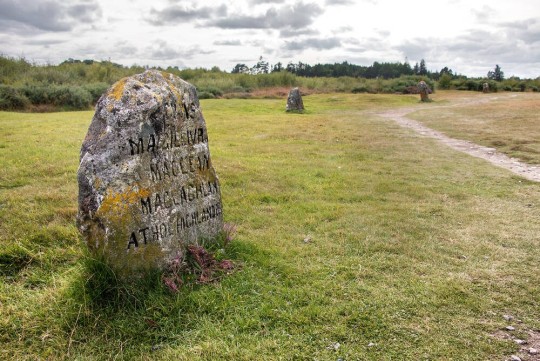
Stone cairns mark the mass graves where the various clans fell. Miraculously, Bonnie Prince Charlie escaped to the Outer Hebrides.
#Battle of Culloden#Inverness#Jacobites#Highland uprising#Bonnie Prince Charlie#Drummossie#Duke of Cumberland#UK#Scottish landscapes#mass graves#battlefields#16 April 1746
58 notes
·
View notes
Photo
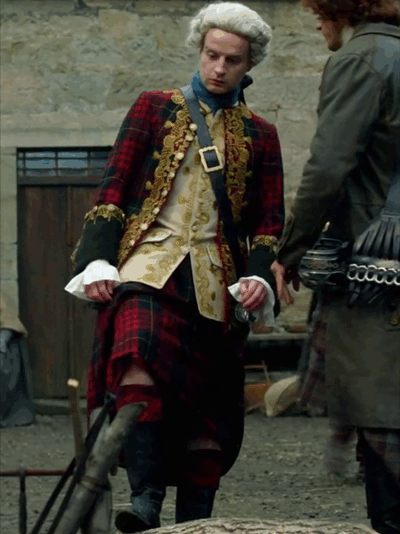
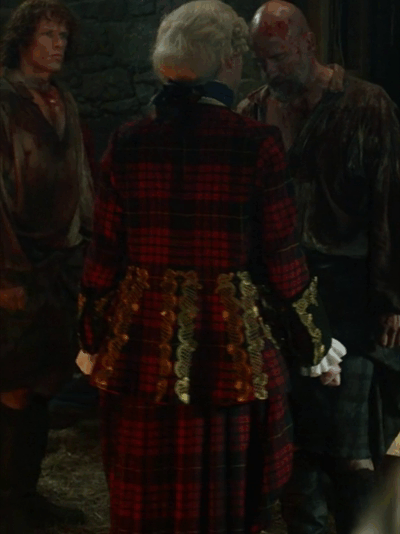


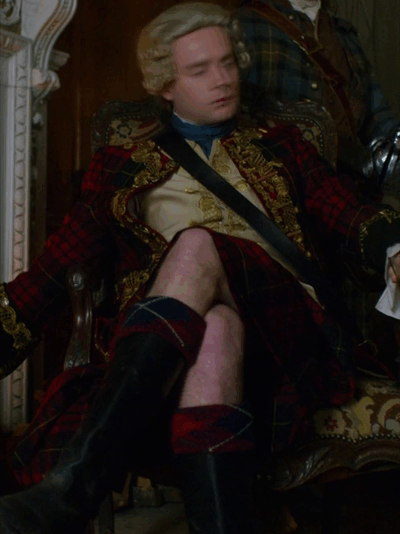
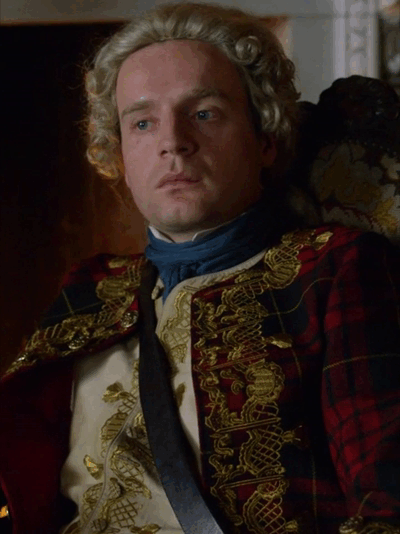


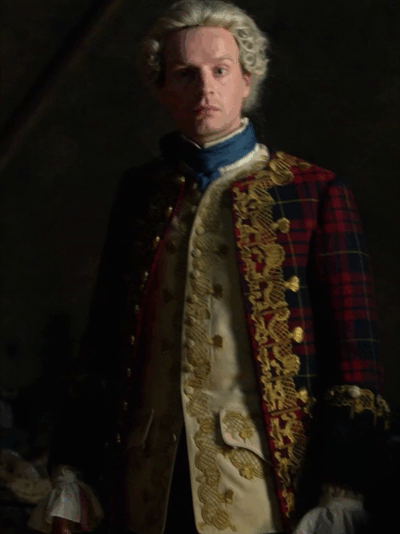
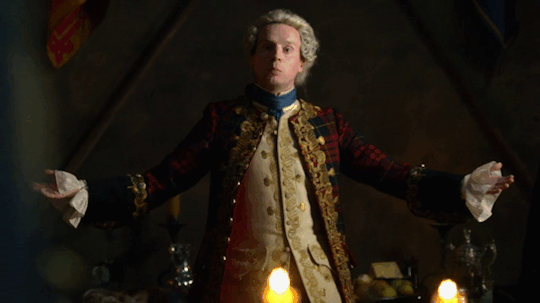
Outlander + Costumes
Charles Edward Stuart’s red, black & golden frock and kilt, creme & golden vest, white shirt and blue necktie in Season 02, Episode 10, 12 & 13 and Season 03, Episode 01.
// requested by anonymous
#Outlander#Charles Edward Stuart#Bonnie Prince Charlie#period drama#perioddramaedit#costume drama#costumes#costumesource#1700s#18th century#red#black#gold#creme#white#blue#Prestonpans#East Lothian#Drummossie Moor#Culloden#Inverness#Scottish Highlands#Scotland#Britain#Europe#requests#Men
67 notes
·
View notes
Text
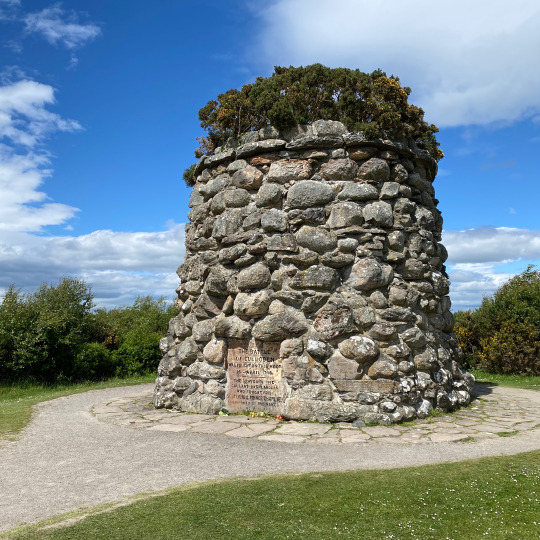

April 16th 1746 saw the Battle of Culloden.
Much has been said about the site of the battle and the Prince has been criticised for “choosing” the moor.
Three sites were scouted in the 48 hours leading up to the battle, they knew Cumberland’s army was coming, their had been skirmishes in the week or so before this day, things were coming to a head.
The first site as at Dalcross Castle, which John Sullivan, the Irish adjutant and quartermaster general, rejected, because the distance across the ravine would have been too small to protect the Jacobite army from British musket fire from the other side.
The second was on the south side of the Nairn, chosen by Lord George Murray. This was poor ground, did not protect the road to Inverness and was vulnerable to British mortar fire from the other side of the river. It is clear that this site was a prelude to retreat and the dissolution of the army, because it was not an effective battle site.
The third site was about 1km east of where the battle was eventually fought, and John Sullivan drew up the army there on 15 April. It was on higher and less boggy ground than the final battlefield, and both wings of the army could see each other, which they could not in the next day’s sleet and rain. No one ‘chose’ the site of the battle on Drummossie Moor as a preference: it was the line closest to headquarters at Culloden House which could defend the road to Inverness.
Many of those soldiers who were asleep after the failed night attack on the 15th had retreated to the grounds of Culloden House, and there was little time to form them up as the British Army approached on the morning of the battle.
Some had urged the Prince to fall back into the hills and glens, split into units and launch a guerrilla campaign, historians can’t agree who ruled this out, some say Lord Murray, others Prince Charles, some a mixture of the two, no matter what it never happened, as we all know.
The battle began around before mid-day, the 9,000 well-rested Government troops advanced downwind across the Moor towards their exhausted opponents who faced directly into the north-east wind and its accompanying sleet. The Prince’s forces numbered about 6,000 and were in two lines. The left flank of the front line was held by the three regiments of MacDonalds, highly resentful that they were not in their traditional place of honour on the right, held by the Atholl Brigade.
In the centre were some of the best of the Jacobite infantry, veterans of the victories at Prestonpans and Falkirk: Lord Lovat’s Frasers, the MacLeans, Mackintoshes, McLachlans and Chisholms. Weak in artillery, the Jacobite frontline could see Cumberland’s gunners unlimbering and loading their batteries of cannon. Receiving no order to unleash the fearsome Highland charge, by far their best weapon, they must have known what was coming.
And come it did; Cumberland opened fire with roundshot across the unobstructed moorland. Behind his artillery, the Duke’s own front line consisted of six regular infantry battalions; the Royal Regiment on the right, opposite the MacDonalds, with Barrell’s Regiment on the left, facing the Athollmen. The second line contained six more infantry battalions, with yet three more in a third line alongside two squadrons of light cavalry. Out on his flanks were the feared heavy Dragoons: Cobham’s on the right, Kerr’s on the left. All was ready for the Jacobite charge.
Cumberland’s infantry had been given intensive training on how to deal with the onrushing Highlander, claymore in right hand, targe on his left. Having fired his Brown Bess musket, each man was to use his socketed bayonet to attack the opponent on his right front, trusting that his own comrade to his immediate left would do the same.
This was designed to avoid the parrying effect of the targe and inflict a disabling wound in the first shock of contact.
For a full half-hour the Government artillery thundered on unchallenged, roundshot and then grapeshot hammering into the Prince’s waiting battalions. Still no order to charge came as scores of men went down, thinning the ranks and producing frantic calls from officers and men to be released to the charge. Eventually they went off anyway.
The MacDonalds crashed in to Barrell’s Regiment, overrunning the front line before losing momentum and being shot and bayoneted by the upcoming second rank. Elsewhere the charge was even less successful; depleted by cannon fire and decimated by the rolling volleys of the infantry, Highland courage and dash proved no match for regular infantry discipline. The charge reeled backwards leaving up to a thousand dead in front of and among the Government positions.
Cumberland ordered a general advance and unleashed his cavalry. What had been a battle was now a rout. It had lasted an hour.
Jacobite casualties are estimated at 1,500 dead, with an unknown number of wounded and fugitives bayoneted and shot in the merciless pursuit that followed.Cumberland lost only 59 dead and 250 wounded, the only senior officer to die being Lord Robert Kerr, commander of grenadiers in Barrell’s Regiment and a son of the Marquess of Lothian.
It was over; the military neutralisation of the Highlands was about to begin.
The ease in which the Government troops surprised Cumberland, and he surprised further when the Jacobites did not regroup and force another battle, he certainly expected another, but none came, around 1000 gathered the following day at Ruthven Barracks, where a written order from Prince Charles told them to “seek their own safety” and disband. But, for many, surrendering was too dangerous an option.
As time went on, the risks of Jacobites handing themselves in became clear. The mood of the Ruthven meetings was downcast. Many fought on to avoid capture or because the risk of surrendering was high. In June, a number of Jacobites went into Fort William after the British government promised six weeks’ immunity. Captain Scott drowned them in a salmon net.
Jacobites engaged in low-level disruption, raiding and protection of vulnerable tenantry as well as recruitment to the Irish Brigade and probably Scottish regiments in French service, including Ecossais Royales.
Assassinations of unpopular government officers or sympathisers were also recorded. The British government still considered the Jacobite threat to be “major” at this time with around 12,000 to 13,000 soldiers deployed across the entire country – from Berwick and Stranraer to Elgin, Forres, Stonehaven, Inverbervie and Montrose – by the end of August 1746.
As government forces mobilised, significant units of armed Jacobites continued to appear in the field. At the end of April, 120 armed MacGregor men were recorded in Balqhuidder after marching home ‘colours flying and pipes playing’ with the Army unwilling to tackle or pursue Jacobite units that maintained discipline.
One battalion of Lochiel’s regiment was still operational in May – as were 500 men under Clanranald. Orkney remained under Jacobite control until late that month and, despite British attacks, four local Jacobite lairds remained successfully hidden
Clans made concerted attempts to resist Cumberland and his men with around a dozen chiefs meeting at Mortlaig in early May. At the meeting… they entered into a bond for their mutual defence and agreed never to lay down their arms, or make a general peace without the consent of the whole,” according to an 1832 account by James Browne.
“By the bond of association, the chiefs agreed…to raise on behalf of the prince and in defence of their country, as many able-bodied armed men as they could on their respective properties.”
Around 600 men gathered later that month across the north and west but the clans “ultimately did not have the time or morale to raise or retain enough men in the field.
Although a unified response failed to materialise, Jacobites remained active across Scotland. Jacobite expresses – the non-stop delivery of letters by horse – continued until August. A British regiment was deployed across Banffshire in the summer of 1746 with insurgents reported in Argyll that September.
Arms were surrendered in the Mearns right into the summer of 1748. British atrocities were carried out against innocent victims, but there were plenty of continuing Jacobite threats and remained so for some time, this led to the building of roads and bridges, to make it easier for troops to be deployed into the heart of the country, many still used to this day, these projects and the act of proscription meant the end of the old Highland way of life.
Many of us have made our pilgrimages to Culloden to pay our respects to those that died that day, and to the commemorations, both on the day, and at the one at midnight the night before, I hope you all take a moment and remember the brave men who fell that day and afterwards…………
49 notes
·
View notes
Text
CLAN CARRUTHERS -CULLODEN- THE MOST TACTICALLY SIGNIFICANT DAYS
CLAN CARRUTHERS INT SOCIETY CCIS PROMPTUS ET FIDELIS

CULLODEN – THE MOST TACTICALLY SIGNIFICANT DAYS
On the 15th April 1746, one of the most tactically significant days for the survival or downfall of Jacobitism occurred. Within that day an entire regiment would be taken prisoner, and in the next 48 hours over 1,550 men would be dead, with more dying of wounds or to…
View On WordPress
#Ancient and Honorable Society of Carruthers Clan Int LLC#carrothers#Carruthers#carruthers battles#Carruthers Clan#carruthers family history#Carruthers history#Carruthers in the Military#CULLODEN#DRUMMOSSIE MUIR#EARL OF CROMARIE#JACOBITES#MACGREGOR#MACKINNONS#MACLEOD
0 notes
Text
The Spaceport
A conversation in a spaceport bar leaves Jamie feeling a bit confused.
on ao3.
“So.” Leaning into her chair, Sam tilted her her head back, her eyes drifting over towards the Doctor. He had made it to the bar, leaning across it to talk to the barkeeper, one fist held up to his ear with his index and pinky fingers sticking out. Whatever he was miming was totally inscrutable to Jamie, but the barkeeper seemed to understand it well enough, straightening up and wandering away into the back room. Shrugging to herself, Sam swung her feet up onto the Doctor’s chair, crossing one leg over the other quite delicately for someone wearing boots that looked like they were made of more metal than leather.
She was… a strange girl, Sam. Good strange, Jamie was quick to silently tell himself. There was a clear, no-nonsense way about her that he liked. It could verge on brusque, at times, but there was always a twinkle of humour in her eyes as she spoke, and she had a quick, wry tongue. And it was not often that someone could keep pace with the Doctor’s enthusiasm, either. She had managed admirably, occupying him for a solid half hour in an animated discussion about spaceship engines and the merits of various fuels. Their verbal sparring had left Jamie with nothing to do but nurse his drink and periodically check his watch, wondering if Ben and Polly might be kind enough to arrive a few minutes early.
They hadn’t, in the end. And so the Doctor had gone to ask the barkeeper if he could borrow some sort of contraption to check on them. But left alone with Sam, he did not feel nearly so awkward as he had been expecting. A few months ago, he might not have known what to make of her, with her close-cropped hair and firm, oil-greased-palm handshake and trousers absolutely covered in straps and pockets and holsters for tools. Now, though, he could see more clearly that he was the anomaly, perched a bit too politely on a rusty metal stool in a run-down spaceport bar. He liked Sam, anyway. That was the important thing.
She was a bit like Polly, in a way, he thought. They had the same sort of sisterliness about them, not afraid to comfort but not afraid to tease, either. Idly, he wondered if Sam had any siblings. Or if Polly did. He had never thought to ask.
“You and the Doctor,” Sam carried on, swirling her drink around in its bottle. “How’d you meet him?”
Well, there was a tricky one to start. “After a battle,” he said. The Doctor had warned him over and over again about telling people too much – letting on that they were time travellers – but Sam didn’t need to know which battle he was talking about. She must have her suspicions anyway, he thought, with the way the Doctor had been talking about spaceships that he claimed would be after her time. “We lost,” he added curtly.
“Oh.” A little of the humour faded out of Sam’s eyes, replaced by apparently genuine regret. “I’m sorry, I didn’t mean -”
“Och, don’t worry.” He flicked one hand dismissively. “It’s been -” How long had it been? A few weeks? A few months? It felt so far away, now, after all this time with the Doctor. Not always, and definitely not at night, when he woke up sweaty and gasping from some half-remembered dream. Sometimes it only seemed like yesterday that the Doctor had plucked him off Drummossie moor. But here, sitting at a table in a seedy spaceport bar with a girl who fixed spaceships for a living – all that blood and screaming and cannonfire could have been a lifetime ago. Could have been someone else’s memories. He was glad of it, really. “Don’t worry,” he repeated. “Anyway, the Doctor was there, an’ -”
“You just took off in his spaceship,” Sam finished for him, grinning.
“It’s a wee bit more complicated than that,” Jamie protested. “He saved our lives, me an’ - an’ a few friends.”
At some point, he was sure, Sam would lean back far enough in her chair that it would topple over. The thing already had its two battered front legs off the ground, but somehow she leant back even further, tipping her head over to take a swig of her drink. Stronger than the cheap and nasty rocket fuel the spaceport sold, she had said, and she grimaced every time she swallowed. When she set the bottle down again, though, a little red circle on the label caught Jamie’s eye. Alcohol free. Strong only in its bitterness, apparently.
“Your friends who’ve gone to old Newbry’s office?” she asked.
Jamie shook his head. “Ben an’ Polly were already travellin’ with the Doctor when I met him. It was Polly that asked me tae join them.”
The bottle was halfway to Sam’s lips when she paused again. “So what happened to your other friends? Or are they hiding in that box of yours?”
“Left. Gone tae Fr-” He caught himself just in time. “Gone somewhere else. I didnae want tae go with them. Was gonnae go home, but -”
“But then you went along with the Doctor instead,” Sam finished again, nodding. Like it was the most obvious thing in the world, and not something Jamie had spent night after sleepless night debating with himself. Well, it had seemed obvious at the time, he supposed, in the delirious simplicity of hunger and exhaustion and adrenaline and fear. Whether it seemed obvious afterwards was a different question. He raised his own bottle to his lips, just for something to do with his hands. “Love at first sight, then, was it? With the Doctor?”
It took him a moment to realise exactly what she had meant – but when he did, any thoughts of whether he should have stayed in Scotland flew out of his head. His drink caught in his throat, leaving him coughing and spluttering and wheezing, half-doubled over to pound his fist against his stomach in the hopes of hacking the mouthful back up again. When at last he emerged, watery-eyed and hoarse, Sam was frowning at him a little bemusedly.
Well, he supposed, that was one way of distracting himself from wondering if he should have stayed behind. Not that he was too keen on repeating the experience.
“What?” he rasped out at last.
“Well, you must’ve liked him, to jump in his spaceship when you’d only just met him.”
“Polly invited me,” Jamie repeated, a bit too weakly. “No’ the Doctor.”
But Sam was smiling wistfully, like she was not really hearing him. “I did that, a long time ago. A girl asked me if I wanted to leave the backwater of a planet I grew up on.”
Despite himself, he was curious. “What happened?” The question tumbled out of his mouth before he could decide whether asking would confirm Sam’s suspicions for her. Her very wrong suspicions, he added to himself. “To her, I mean.”
Sam burst into laughter at that, though Jamie could not see what was so funny. “You’ve met her,” she said. “At the scrap shop, remember?” Frowning, Jamie thought back to the dusty little scrap shop. There had been nobody there except - “Aliye.”
“But -” He remembered Aliye, alright. It was the rest of it that was giving him trouble. Any shock he might once have felt at Sam having a wife paled before his incredulity that a human – or someone who looked so human, anyway – could be married to someone with six arms and blue skin and a face like a cat. At least the Doctor looks human. The thought drifted through his mind out of nowhere, and he scowled at it. All Sam’s questioning must be confusing him. “You’re married tae her?”
“Mmhm.” Sam was eyeing him oddly. Well, Jamie supposed, she had been born hundreds of years after him. Maybe even thousands of years. It was probably perfectly normal for women to have wives with too many limbs and alien faces. “What’re a bunch of nice people like you doing in a place like this, anyway?”
“Eh?”
“Well, you know.” Sweeping her bottle around her in a wide arc, Sam gestured at the bar around them.
It was hardly that bad, Jamie thought. Lanterns hanging from the metal beams that criss-crossed the ceiling gave out the only light, yellow and greasy, and the tables were pitted with indents from knives and blackened with blasts from the funny light-guns people had in the future, and most of the other occupants were either too loud or too quiet – but it was not that bad.
“I’ve seen worse,” he said. Sam raised her eyebrows, and he shrugged in silent admission. “Alright, maybe I haven’t. But I’d rather be here than – well, a lot of other places.” Now it was Sam’s turn to shrug. “An’ what about you? An’ Aliye? You’re nice, aren’t ye?”
That made Sam laugh, deep and loud. “If you want to put it that way, sure. But we don’t plan on staying long. We’d have been off once Aliye finished that job, if you lot hadn’t come along.”
“Sorry we kept ye.”
“Don’t be sorry.” Sam laughed again. “Best fun I’ve had in years, hijacking that spaceship. But we’ve been around this sort of place before. Your Doctor seem to know his way around, alright, but the rest of you...”
“We didnae mean tae come here,” Jamie explained. “We just – arrived.”
“Mm.” Apparently done with leaning back in her chair, Sam let its front legs crash to the floor again. “Most people who arrive somewhere by accident go sightseeing, you know. They don’t steal the local gang leader’s spaceship and almost crash it into an asteroid.”
“Aye, well.” Jamie grinned, rubbing at his shoulder a little ruefully. Crashing into the asteroid would have been a death sentence, he knew – but swerving away from the thing at the last minute had hardly been painless. “That’s what ye get, when you’re travellin’ with the Doctor. Ye learn tae accept it.” He half-turned his head, his gaze drifted over to the bar where the Doctor still stood, some wee device clutched in one hand. He was talking animatedly to the barkeeper, gesturing wildly. “I’m no’ going tae marry him,” he said, almost automatically.
“Whatever you say.” Sam was watching him too now, sighing. “Looks like he’s out of money to pay for the phone.”
Twisting around again, Jamie sighed when he saw that the Doctor's discussion with the barkeeper was starting to look a bit heated. “’Course he is,” he muttered, more to himself than to Sam. “I’d better go an’ see if he’s alright,” he added more loudly.
Sam grinned. “Here,” she said, reaching down to rummage in one of her many pockets. She withdrew her hand once with a small spanner – twice with a handful of nuts and bolts – three times with a motley collection of wrapped sweets. For one startling moment, Jamie could have believed he was looking at the Doctor, not Sam. At last, she delved in to find a palmful of tarnished silver coins. “Give him these.”
“I can’t -”
“Go on.” She held her hand out further towards him.
He took them slowly, a little jerkily, wondering all the way if she was about to pull her hand away and close her fingers around the coins. But she just broadened her smile and flexed her fingers outwards invitingly until the coins were warm and solid in his hand.
“Thanks,” he said, struggling to turn his confused frown into an appreciative smile. “I dinnae think we have anythin’ tae repay ye with -”
“Consider it a gift.” Sam was lounging back in her chair again now, the neck of her bottle held between two fingers so it dangled loosely over the table. Her eyes had moved away from Jamie, and he did not have to turn to know what – or rather, who – was making her face light up like that. “Here’s Aliye,” she said, sure enough. “Now -” She tilted her head towards the bar. “Go and help him out.”
Shrugging to himself, Jamie pushed himself up to wander a little aimlessly across the room, flashing a grin at Aliye as he passed. She waved two of her arms at him in return, but her eyes were keenly fixed on Sam.
When he was halfway to the bar, he glanced over his shoulder, looking back towards the pair of them. Aliye had sat down beside Sam, the two of them leaning their heads together conspiratorially. A moment later, Sam met Jamie’s eyes, winking at him. Cheeks reddening, he turned away.
He took in a deep breath before striding over more confidently to clap the Doctor on the back. “Here,” he said, holding out his fistful of coins. “Use these.”
7 notes
·
View notes
Text
Culloden
The Battle of Culloden was the final confrontation of the Jacobite rising of 1745.
On this date, 16 April 1746, the Jacobite army of Charles Edward Stuart was decisively defeated by a British government force under Prince William Augustus, Duke of Cumberland, on Drummossie Moor near Inverness in the Scottish Highlands.
1250 Jacobites died at the battle, and almost as many were wounded with 376…

View On WordPress
0 notes
Text
Old MacDonald had a farm
Old MacDonald had a farm
The end of Jacobite ambitions on the bloody battlefield of Culloden’s Drummossie Moor on a cold, windswept April morning in 1746 was not the end of the story for its principal protagonist. While the Government would have preferred the end to feature the end of a rope, Prince Charles Edward Stuart, “The Young Chevalier” and rightful heir to the thrones of the United Kingdom of Great Britain and…
View On WordPress
#Battle of Culloden#Bonnie Prince Charlie#Catherine MacDonald#Darebin Creek#Flora MacDonald#Floraville#John MacDonald#Plenty River#Skye Boat Song#The Station Plenty#Yallambee#Yallambie
0 notes
Text



On 16th April 1746, the Jacobite army was defeated by Hanoverian forces in the Battle of Culloden.
I've covered the battle in depth many times over the years so I thought today I would tell you about a man many of you will not have heard of, Roderick MacKenzie.
In the terrible aftermath of the battle when Government troops were searching the hills looking for Prince Charlie with the promise of a £30,000 reward being offered for his capture, the garrison at Fort Augustus became suspicious that Charles was somewhere in the district. Patrols and search parties were constantly out combing the area. Certainly the Prince was at large in the hills around Glen Moriston for weeks, staying for part of the time in a cave at Corridoe, protected by the eight men of Glen Moriston.
The stories differ a little, one says that young Roderick, the son of an Edinburgh jeweller was with the Prince's party when they came across Government troops and he drew them away from Charlie and his men, another says that the Redcoats happened upon him as they were going about their "work" of killing any jacobites they should encounter after the rout at Drummossie , both stories tell of Roderick on being challenged, did not turn and flee, giving himself a slight chance of survival, the brave man turned to face his enemy, who fired a volley of shots cutting MacKenzie down and fatally injuring him, BUT with his last vestiges of breath displaying a courage and quickness of thought amazing for a dying man he called out 'You have killed your Prince."
Roderick MacKenzie is said to have been the same build and of similar looks to Bonnie Prince Charlie, and the patrol, deceived by the words and the resemblance, were sure that they had killed the Prince, and no doubt were already thinking of how they would spend that £30,000 reward. They cut the head off the body, and carried it proudly back to Fort Augustus. It happened that Cumberland, the Butcher in command of the Hanoverian forces, was there. Cumberland was uncertain about the head. It certainly looked like the Prince. He had the head sent of to London to be identified but there was no one in London able to do that. Only one man, it was thought, could be certain, and that was Peter Morrison, the Prince's batman, and he was lying in Carlisle Castle, awaiting execution. So Peter Morrison was sent for, but by this time it was too late, the head was far too decayed for identification. Something good did come out of it, for Peter Morrison's sentence was commuted, and eventually he was freed.
Cumberland himself was was either convinced enough by the severed head, or he had enough of Scotland and returned to London shortly after and back to the "high society" he so sorely missed. With the Butcher gone, the vigilance and enthusiasm of the troops was lessened, and Prince Charles Edward was able to break through and win to the west.
Legend has it the headless body of Roderick Mackenzie lies in a quiet grave just off the A887 on the road to Invermoriston. Certainly there is a memorial to this very gallant young man by the side of the road a cairn was erected nearby which reads:
'At this spot in 1746 did Roderick Mackenzie, an officer in the army of Prince Charles, of the same size and similar appearance to his Royal Prince. When surrounded and overpowered by the troops of the Duke of Cumberland, gallantly died in attempting to save his fugitive leader from further pursuit.'
Each year Clan MacKenzie members meet at the grave for a memorial service.So we salute Roderick MacKenzie, one of the unsung heroes who died, maybe not at Culloden, but certainly in the days afterwards.
19 notes
·
View notes
Photo



April 16th 1746 saw the Battle of Culloden.
Much has been said about the site of the battle and the Prince has been criticised for “choosing” the moor.
Three sites were scouted in the 48 hours leading up to the battle, they knew Cumberland’s army was coming, their had been skirmishes in the week or so before this day, things were coming to a head.
The first site as at Dalcross Castle, which John Sullivan, the Irish adjutant and quartermaster general, rejected, because the distance across the ravine would have been too small to protect the Jacobite army from British musket fire from the other side.
The second was on the south side of the Nairn, chosen by Lord George Murray. This was poor ground, did not protect the road to Inverness and was vulnerable to British mortar fire from the other side of the river. It is clear that this site was a prelude to retreat and the dissolution of the army, because it was not an effective battle site.
The third site was about 1km east of where the battle was eventually fought, and John Sullivan drew up the army there on 15 April. It was on higher and less boggy ground than the final battlefield, and both wings of the army could see each other, which they could not in the next day’s sleet and rain. No one ‘chose’ the site of the battle on Drummossie Moor as a preference: it was the line closest to headquarters at Culloden House which could defend the road to Inverness.
Many of those soldiers who were asleep after the failed night attack on the 15th had retreated to the grounds of Culloden House, and there was little time to form them up as the British Army approached on the morning of the battle.
Some had urged the Prince to fall back into the hills and glens, split into units and launch a guerrilla campaign, historians can’t agree who ruled this out, some say Lord Murray, others Prince Charles, some a mixture of the two, no matter what it never happened, as we all know.
The battle began around before mid-day, the 9,000 well-rested Government troops advanced downwind across the Moor towards their exhausted opponents who faced directly into the north-east wind and its accompanying sleet. The Prince’s forces numbered about 6,000 and were in two lines. The left flank of the front line was held by the three regiments of MacDonalds, highly resentful that they were not in their traditional place of honour on the right, held by the Atholl Brigade.
In the centre were some of the best of the Jacobite infantry, veterans of the victories at Prestonpans and Falkirk: Lord Lovat’s Frasers, the MacLeans, Mackintoshes, McLachlans and Chisholms. Weak in artillery, the Jacobite frontline could see Cumberland’s gunners unlimbering and loading their batteries of cannon. Receiving no order to unleash the fearsome Highland charge, by far their best weapon, they must have known what was coming.
And come it did; Cumberland opened fire with roundshot across the unobstructed moorland. Behind his artillery, the Duke’s own front line consisted of six regular infantry battalions; the Royal Regiment on the right, opposite the MacDonalds, with Barrell’s Regiment on the left, facing the Athollmen. The second line contained six more infantry battalions, with yet three more in a third line alongside two squadrons of light cavalry. Out on his flanks were the feared heavy Dragoons: Cobham’s on the right, Kerr’s on the left. All was ready for the Jacobite charge.
Cumberland’s infantry had been given intensive training on how to deal with the onrushing Highlander, claymore in right hand, targe on his left. Having fired his Brown Bess musket, each man was to use his socketed bayonet to attack the opponent on his right front, trusting that his own comrade to his immediate left would do the same.
This was designed to avoid the parrying effect of the targe and inflict a disabling wound in the first shock of contact.
For a full half-hour the Government artillery thundered on unchallenged, roundshot and then grapeshot hammering into the Prince’s waiting battalions. Still no order to charge came as scores of men went down, thinning the ranks and producing frantic calls from officers and men to be released to the charge. Eventually they went off anyway.
The MacDonalds crashed in to Barrell’s Regiment, overrunning the front line before losing momentum and being shot and bayoneted by the upcoming second rank. Elsewhere the charge was even less successful; depleted by cannon fire and decimated by the rolling volleys of the infantry, Highland courage and dash proved no match for regular infantry discipline. The charge reeled backwards leaving up to a thousand dead in front of and among the Government positions.
Cumberland ordered a general advance and unleashed his cavalry. What had been a battle was now a rout. It had lasted an hour.
Jacobite casualties are estimated at 1,500 dead, with an unknown number of wounded and fugitives bayoneted and shot in the merciless pursuit that followed.Cumberland lost only 59 dead and 250 wounded, the only senior officer to die being Lord Robert Kerr, commander of grenadiers in Barrell’s Regiment and a son of the Marquess of Lothian.
It was over; the military neutralisation of the Highlands was about to begin.
The ease in which the Government troops surprised Cumberland, and he surprised further when the Jacobites did not regroup and force another battle, he certainly expected another, but none came, around 1000 gathered the following day at Ruthven Barracks, where a written order from Prince Charles told them to “seek their own safety” and disband. But, for many, surrendering was too dangerous an option.
As time went on, the risks of Jacobites handing themselves in became clear. The mood of the Ruthven meetings was downcast. Many fought on to avoid capture or because the risk of surrendering was high. In June, a number of Jacobites went into Fort William after the British government promised six weeks’ immunity. Captain Scott drowned them in a salmon net.
Jacobites engaged in low-level disruption, raiding and protection of vulnerable tenantry as well as recruitment to the Irish Brigade and probably Scottish regiments in French service, including Ecossais Royales.
Assassinations of unpopular government officers or sympathisers were also recorded. The British government still considered the Jacobite threat to be “major” at this time with around 12,000 to 13,000 soldiers deployed across the entire country – from Berwick and Stranraer to Elgin, Forres, Stonehaven, Inverbervie and Montrose – by the end of August 1746.
As government forces mobilised, significant units of armed Jacobites continued to appear in the field. At the end of April, 120 armed MacGregor men were recorded in Balqhuidder after marching home ‘colours flying and pipes playing’ with the Army unwilling to tackle or pursue Jacobite units that maintained discipline.
One battalion of Lochiel’s regiment was still operational in May – as were 500 men under Clanranald. Orkney remained under Jacobite control until late that month and, despite British attacks, four local Jacobite lairds remained successfully hidden
Clans made concerted attempts to resist Cumberland and his men with around a dozen chiefs meeting at Mortlaig in early May. At the meeting… they entered into a bond for their mutual defence and agreed never to lay down their arms, or make a general peace without the consent of the whole,” according to an 1832 account by James Browne.
“By the bond of association, the chiefs agreed…to raise on behalf of the prince and in defence of their country, as many able-bodied armed men as they could on their respective properties.”
Around 600 men gathered later that month across the north and west but the clans “ultimately did not have the time or morale to raise or retain enough men in the field.
Although a unified response failed to materialise, Jacobites remained active across Scotland. Jacobite expresses – the non-stop delivery of letters by horse – continued until August. A British regiment was deployed across Banffshire in the summer of 1746 with insurgents reported in Argyll that September.
Arms were surrendered in the Mearns right into the summer of 1748. British atrocities were carried out against innocent victims, but there were plenty of continuing Jacobite threats and remained so for some time, this led to the building of roads and bridges, to make it easier for troops to be deployed into the heart of the country, many still used to this day, these projects and the act of proscription meant the end of the old Highland way of life.
Many of us have made our pilgrimages to Culloden to pay our respects to those that died that day, and to the commemorations, both on the day, and at the one at midnight the night before, I hope you all take a moment and remember the brave men who fell that day and afterwards…………
94 notes
·
View notes
Photo





The 16th of April 1746 is a date etched firmly in the minds of many Scots, it not only marked the date of The Battle of Culloden, it was also the catalyst for The Highland Clearances.
The Jacobite army at Culloden was organised along regimental lines, with the regiments normally named after their commanders, as was still the case in the British army at the time. They were drilled using a mixture of French and British tactics and they had a large amount of artillery (much reduced at Culloden, owing to transport difficulties). The battle of Culloden had to be fought because the Jacobite army needed to protect Inverness, its last major supply depot. As it was, supplies were low. Charles’s army was too large and too conventionally organised to fight a guerilla war, and would have broken up if this had been attempted. Nor was it a ‘clan’ army: many of its units were from the Scottish lowlands, as well as Irish and Scottish soldiers in the French service, and some English volunteers
Indeed, at Culloden some of the most effective units were not Highland ones: the Forfarshire Regiment held its shape and retired in good order; most of the men made it home safely to Angus. And some of the bravest actions of the battle were carried out by Lord Lewis Gordon’s brigade from Aberdeen and Banff, Lord John Drummond’s Royal Scots in the French service and Viscount Strathallan’s Perthshire Horse. Army orders were given in English, not Gaelic.
Many of the paintings that you see of the highlanders attacking with their swords are very misleading, yes they would have had swords for close contact fighting, but if you look at the picture of the models of two Jacobite soldiers, most had musket with bayonets. The people these models are made for are meticulous in their research, and arguably have a better understanding of what happened on Drumossie Moor that day than most of us, they play out the events many times with their friends in their “war game”
Much has been said about the site of the battle and the Prince has been criticised for "choosing" the moor. Three other sites were scouted in the 48 hours leading up to the battle.
The first was at Dalcross Castle, which John Sullivan, the Irish adjutant and quartermaster general, rejected, because the distance across the ravine would have been too small to protect the Jacobite army from British musket fire from the other side.
The second was on the south side of the Nairn, chosen by Lord George Murray. This was poor ground, did not protect the road to Inverness and was vulnerable to British mortar fire from the other side of the river. It is clear that this site was a prelude to retreat and the dissolution of the army, because it was not an effective battle site.
The third site was about 1km east of where the battle was eventually fought, and John Sullivan drew up the army there on 15 April. It was on higher and less boggy ground than the final battlefield, and both wings of the army could see each other, which they could not in the next day’s sleet and rain.
So no one really ‘chose’ the site of the battle on Drummossie Moor as a preference: it was the line closest to headquarters at Culloden House which could defend the road to Inverness.
Many of those soldiers who were asleep after the failed night attack on the 15th had retreated to the grounds of Culloden House, and there was little time to form them up as the British Army approached on the morning of the battle.
'Twas love of our prince drove us all to Drumossie
But in scarcely the time that it takes me to tell
The flower of our country lay scorched by an army
A lot of people see the battle as a catholic v protestant affair, this might be true of the belligerents leaders, Bonnie Prince Charlie and the Stewarts throughout history were in the main, Catholics, George II was Protestant, both men were born on mainland Europe and both had both Catholic and Protestants among their armies.
Statistically, the most likely recruit for the Jacobite army was from the north east of Scotland and an adherent of the Scottish Episcopal Church, which was roughly equivalent to the Church of England. Episcopalians supported the Stuarts because they believed that if they were restored, Presbyterianism would be disestablished in Scotland. Most of the Highlanders who fought for the Stuarts were Episcopalian too.
Though there were a number of Catholics, they were not in the majority of the army, and certainly a minority once the Scottish and Irish troops in the French service are excluded.
By 1698 the reformation one both sides of the border meant there were fewer Catholics, the majority who were, were of the nobility and even the vast majority of them had to keep their religion secret for fear of persecution. The Jacobites were also used as pawns by the Catholic nations of Europe at the time, mainly the French, who may have helped win a victory for Bonnie Prince Charlie and his troops had they delivered fully on their promises.
I’ll round this post up by adding this poem written by Alice Macdonell of Keppoch, writing at the end of the 19th Century, after seeing it in the rain in autumn.
Culloden Moor (Seen in Autumn Rain)
Full of grief, the low winds sweep
O'er the sorrow-haunted ground;
Dark the woods where night rains weep,
Dark the hills that watch around.
Tell me, can the joys of spring
Ever make this sadness flee,
Make the woods with music ring,
And the streamlet laugh for glee?
When the summer moor is lit
With the pale fire of the broom,
And through green the shadows flit,
Still shall mirth give place to gloom?
Sad shall it be, though sun be shed
Golden bright on field and flood;
E'en the heather's crimson red
Holds the memory of blood.
Here that broken, weary band
Met the ruthless foe's array,
Where those moss-grown boulders stand,
On that dark and fatal day.
Like a phantom hope had fled,
Love to death was all in vain,
Vain, though heroes' blood was shed,
And though hearts were broke in twain.
Many a voice has cursed the name
Time has into darkness thrust,
Cruelty his only fame
In forgetfulness and dust.
Noble dead that sleep below,
We your valour ne'er forget;
Soft the heroes' rest who know
Hearts like theirs are beating yet.
92 notes
·
View notes
Photo


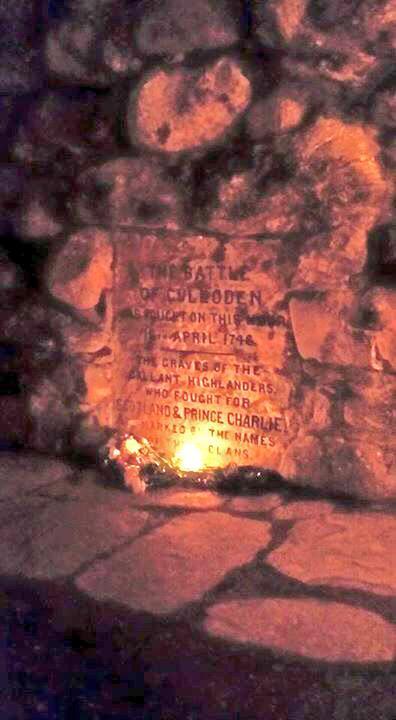
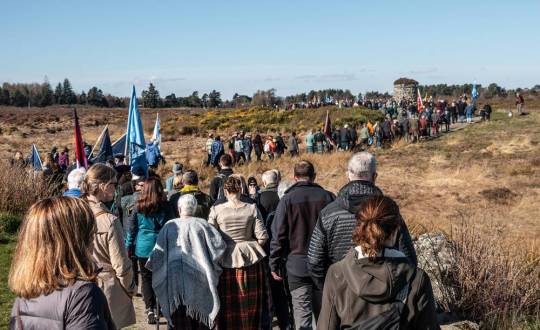
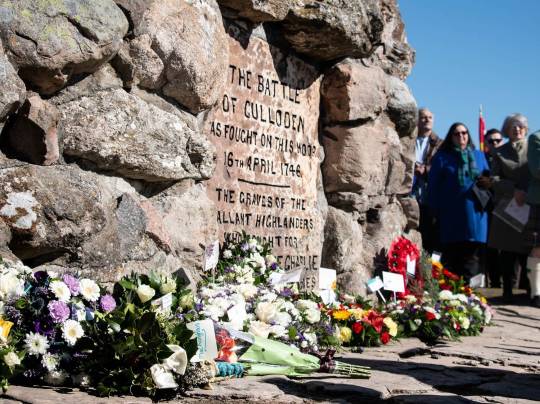
April 16th 1746 saw the Battle of Culloden.
Today I wont so much be covering the battle itself as I have in previous years, I will post a bit about how Culloden became the site of the battle and the aftermath. By the aftermath, again I wont be treading over ground covered and the treatment of Highlanders, but will instead follow what was left of the Jacobite army and what they did in the days, weeks and indeed months after the battle.
Much has been said about the site of the battle and the Prince has been criticised for "choosing" the moor.
Three sites were scouted in the 48 hours leading up to the battle, they knew Cumberland's army was coming, their had been skirmishes in the week or so before this day, things were coming to a head.
The first site as at Dalcross Castle, which John Sullivan, the Irish adjutant and quartermaster general, rejected, because the distance across the ravine would have been too small to protect the Jacobite army from British musket fire from the other side.
The second was on the south side of the Nairn, chosen by Lord George Murray. This was poor ground, did not protect the road to Inverness and was vulnerable to British mortar fire from the other side of the river. It is clear that this site was a prelude to retreat and the dissolution of the army, because it was not an effective battle site.
The third site was about 1km east of where the battle was eventually fought, and John Sullivan drew up the army there on 15 April. It was on higher and less boggy ground than the final battlefield, and both wings of the army could see each other, which they could not in the next day’s sleet and rain. No one ‘chose’ the site of the battle on Drummossie Moor as a preference: it was the line closest to headquarters at Culloden House which could defend the road to Inverness.
Many of those soldiers who were asleep after the failed night attack on the 15th had retreated to the grounds of Culloden House, and there was little time to form them up as the British Army approached on the morning of the battle.
Some had urged the Prince to fall back into the hills and glens, split into units and launch a guerrilla campaign, historians can't agree who ruled this out, some say Lord Murray, others Prince Charles, some a mixture of the two, no matter what it never happened, as we all know.
The battle began around mid-day, the 9,000 well-rested Government troops advanced downwind across the Moor towards their exhausted opponents who faced directly into the north-east wind and its accompanying sleet. The Prince’s forces numbered about 6,000 and were in two lines. The left flank of the front line was held by the three regiments of MacDonalds, highly resentful that they were not in their traditional place of honour on the right, held by the Atholl Brigade.
In the centre were some of the best of the Jacobite infantry, veterans of the victories at Prestonpans and Falkirk: Lord Lovat’s Frasers, the MacLeans, Mackintoshes, McLachlans and Chisholms. Weak in artillery, the Jacobite frontline could see Cumberland’s gunners unlimbering and loading their batteries of cannon. Receiving no order to unleash the fearsome Highland charge, by far their best weapon, they must have known what was coming.
And come it did; Cumberland opened fire with roundshot across the unobstructed moorland. Behind his artillery, the Duke’s own front line consisted of six regular infantry battalions; the Royal Regiment on the right, opposite the MacDonalds, with Barrell’s Regiment on the left, facing the Athollmen. The second line contained six more infantry battalions, with yet three more in a third line alongside two squadrons of light cavalry. Out on his flanks were the feared heavy Dragoons: Cobham’s on the right, Kerr’s on the left. All was ready for the Jacobite charge.
Cumberland’s infantry had been given intensive training on how to deal with the onrushing Highlander, claymore in right hand, targe on his left. Having fired his Brown Bess musket, each man was to use his socketed bayonet to attack the opponent on his right front, trusting that his own comrade to his immediate left would do the same.
This was designed to avoid the parrying effect of the targe and inflict a disabling wound in the first shock of contact.
For a full half-hour the Government artillery thundered on unchallenged, roundshot and then grapeshot hammering into the Prince’s waiting battalions. Still no order to charge came as scores of men went down, thinning the ranks and producing frantic calls from officers and men to be released to the charge. Eventually they went off anyway.
The MacDonalds crashed in to Barrell’s Regiment, overrunning the front line before losing momentum and being shot and bayoneted by the upcoming second rank. Elsewhere the charge was even less successful; depleted by cannon fire and decimated by the rolling volleys of the infantry, Highland courage and dash proved no match for regular infantry discipline. The charge reeled backwards leaving up to a thousand dead in front of and among the Government positions.
Cumberland ordered a general advance and unleashed his cavalry. What had been a battle was now a rout. It had lasted an hour.
Jacobite casualties are estimated at 1,500 dead, with an unknown number of wounded and fugitives bayoneted and shot in the merciless pursuit that followed.Cumberland lost only 59 dead and 250 wounded, the only senior officer to die being Lord Robert Kerr, commander of grenadiers in Barrell’s Regiment and a son of the Marquess of Lothian.
It was over; the military neutralisation of the Highlands was about to begin.
The ease in which the Government troops surprised Cumberland, and he surprised further when the Jacobites did not regroup and force another battle, he certainly expected another, but none came, around 1000 gathered the following day at Ruthven Barracks, where a written order from Prince Charles told them to “seek their own safety” and disband. But, for many, surrendering was too dangerous an option.
As time went on, the risks of Jacobites handing themselves in became clear. The mood of the Ruthven meetings was downcast. Many fought on to avoid capture or because the risk of surrendering was high. In June, a number of Jacobites went into Fort William after the British government promised six weeks’ immunity. Captain Scott drowned them in a salmon net.
Jacobites engaged in low-level disruption, raiding and protection of vulnerable tenantry as well as recruitment to the Irish Brigade and probably Scottish regiments in French service, including Ecossais Royales.
Assassinations of unpopular government officers or sympathisers were also recorded. The British government still considered the Jacobite threat to be “major” at this time with around 12,000 to 13,000 soldiers deployed across the entire country – from Berwick and Stranraer to Elgin, Forres, Stonehaven, Inverbervie and Montrose – by the end of August 1746.
As government forces mobilised, significant units of armed Jacobites continued to appear in the field. At the end of April, 120 armed MacGregor men were recorded in Balqhuidder after marching home ‘colours flying and pipes playing’ with the Army unwilling to tackle or pursue Jacobite units that maintained discipline.
One battalion of Lochiel’s regiment was still operational in May – as were 500 men under Clanranald. Orkney remained under Jacobite control until late that month and, despite British attacks, four local Jacobite lairds remained successfully hidden
Clans made concerted attempts to resist Cumberland and his men with around a dozen chiefs meeting at Mortlaig in early May. At the meeting... they entered into a bond for their mutual defence and agreed never to lay down their arms, or make a general peace without the consent of the whole,” according to an 1832 account by James Browne.
“By the bond of association, the chiefs agreed...to raise on behalf of the prince and in defence of their country, as many able-bodied armed men as they could on their respective properties.”
Around 600 men gathered later that month across the north and west but the clans “ultimately did not have the time or morale to raise or retain enough men in the field.
Although a unified response failed to materialise, Jacobites remained active across Scotland. Jacobite expresses – the non-stop delivery of letters by horse – continued until August. A British regiment was deployed across Banffshire in the summer of 1746 with insurgents reported in Argyll that September.
Arms were surrendered in the Mearns right into the summer of 1748. British atrocities were carried out against innocent victims, but there were plenty of continuing Jacobite threats and remained so for some time, this led to the building of roads and bridges, to make it easier for troops to be deployed into the heart of the country, many still used to this day, these projects and the act of proscription meant the end of the old Highland way of life.
Many of us have made our pilgrimages to Culloden to pay our respects to those that died that day, and to the commemorations, both on the day, and at the one at midnight the night before, I hope you all take a moment and remember the brave men who fell that day and afterwards............
80 notes
·
View notes
Photo



On 16th April 1746, the Jacobite army was defeated by Hanoverian forces in the Battle of Culloden.
I've covered the battle in depth many times over the years so I thought today I would tell you about a man many of you will not have heard of, Roderick MacKenzie.
In the terrible aftermath of the battle when Government troops were searching the hills looking for Prince Charlie with the promise of a £30,000 reward being offered for his capture, the garrison at Fort Augustus became suspicious that Charles was somewhere in the district. Patrols and search parties were constantly out combing the area. Certainly the Prince was at large in the hills around Glen Moriston for weeks, staying for part of the time in a cave at Corridoe, protected by the eight men of Glen Moriston.
The stories differ a little, one says that young Roderick, the son of an Edinburgh jeweller was with the Prince's party when they came across Government troops and he drew them away from Charlie and his men, another says that the Redcoats happened upon him as they were going about their "work" of killing any jacobites they should encounter after the rout at Drummossie , both stories tell of Roderick on being challenged, did not turn and flee, giving himself a slight chance of survival, the brave man turned to face his enemy, who fired a volley of shots cutting MacKenzie down and fatally injuring him, BUT with his last vestiges of breath displaying a courage and quickness of thought amazing for a dying man he called out 'You have killed your Prince."
Roderick MacKenzie is said to have been the same build and of similar looks to Bonnie Prince Charlie, and the patrol, deceived by the words and the resemblance, were sure that they had killed the Prince, and no doubt were already thinking of how they would spend that £30,000 reward. They cut the head off the body, and carried it proudly back to Fort Augustus. It happened that Cumberland, the Butcher in command of the Hanoverian forces, was there. Cumberland was uncertain about the head. It certainly looked like the Prince. He had the head sent of to London to be identified but there was no one in London able to do that. Only one man, it was thought, could be certain, and that was Peter Morrison, the Prince's batman, and he was lying in Carlisle Castle, awaiting execution. So Peter Morrison was sent for, but by this time it was too late, the head was far too decayed for identification. Something good did come out of it, for Peter Morrison's sentence was commuted, and eventually he was freed.
Cumberland himself was was either convinced enough by the severed head, or he had enough of Scotland and returned to London shortly after and back to the "high society" he so sorely missed. With the Butcher gone, the vigilance and enthusiasm of the troops was lessened, and Prince Charles Edward was able to break through and win to the west.
Legend has it the headless body of Roderick Mackenzie lies in a quiet grave just off the A887 on the road to Invermoriston. Certainly there is a memorial to this very gallant young man by the side of the road a cairn was erected nearby which reads:
'At this spot in 1746 did Roderick Mackenzie, an officer in the army of Prince Charles, of the same size and similar appearance to his Royal Prince. When surrounded and overpowered by the troops of the Duke of Cumberland, gallantly died in attempting to save his fugitive leader from further pursuit.'
Each year Clan MacKenzie members meet at the grave for a memorial service.So we salute Roderick MacKenzie, one of the unsung heroes who died, maybe not at Culloden, but certainly in the days afterwards.
48 notes
·
View notes
Photo


A request from @jfraser22, who asked for info on The Brahan Seer.
This is from my friend Leslie Thomson who is a font of all knowledge with stuff like this and railways, trams etc, more of a geek than me!
Coinneach Odhar, or Kenneth MacKenzie, was born in Uig, on the Isle of Lewis, in either the late 16th or early 17th century. Several legends exist of how he came by his "adder stone", which as a boy he looked through, striking him blind in his left eye. But from that day he was given the gift of Second Sight - the ability to see the hidden and predict the future, and was known as the Brahan Seer.
His prophecies were handed down in oral tradition, and were first published in the 18th century, many of which are said to have come to pass.
~ Full rigged ships shall sail round the back of Tomnahurich. The Caledonian Canal opened in 1822, making this possible.
Some fulfilled prophecies include the following;
~ The day shall come when there will be a bridge over every river, and balls of fire with horseless carriages shall race up and down the Strath of Peffery. The Strathpeffer Railway, which involved bridging many rivers, opened in 1897.
~ When you can cross the River Ness dry-shod in five places, a frightful disaster will strike the world. A fifth bridge over the Ness was built in the last week of August 1939. Hitler invaded Poland, starting World War II, a few days later.
~ The three-legged monster shall go out from Loch Kishorn and devastate the seas. In the 1980s, a massive, three-legged exploration rig was built at Kishorn, Wester Ross.
ummossie Moor with a friend one day, the Brahan Seer commented "Oh! Drumossie, thy bleak moor shall, ere many generations have passed away, be stained with the best blood of the Highlands. Glad am I that I will not see the day, for it will be a fearful period; heads will be lopped off by the score, and no mercy shall be shown or quarter given on either side." Drummossie Moor is better known as Culloden, where the Jacobites made their disastrous last stand in 1746.
~ "The sheep shall eat the men." Said to have been fulfilled in the Highland Clearances.
Coinneach's sight made him quite famous in the highlands, and he was invited to many functions. However, when at a banquet held by Isabella, Lady Seaforth, she asked Coinneach if he could see her husband, the Earl of Seaforth, who was on a visit to Paris. Coinneach would only say that the Earl was in good health, but would not elaborate further. Isabella was unhappy with this, and pressed him, to which Coinneach replied, "Sad to say, my lady, that the Earl is at this moment in the bed of a beautiful maid."
Isabella, outraged, refused to believe the Brahan Seer, and had him seized, and burned alive in a barrel of hot tar.
I sabella, outraged, refused to believe the Brahan Seer, and had him seized, and burned alive in a barrel of hot tar.
It is claimed that Coinneach saw this end coming, and before the banquet, threw his adder stone into a loch, saying that it would be found in the future by "a lame humpbacked mendicant".
Some prophecies of the Brahan Seer have yet to come true. Including one, told in different ways, that Scotland shall be free "at the time of the black rain"; which is believed to be a reference to North Sea Oil.
Meanwhile, on the Isle of Lewis, several islanders refuse to travel on the Ullapool-Stornoway ferry on Sundays, not just because they are strict Sabbatarians, but also because of superstition over one of the Brahan Seer's prophecies; "The Isle of Lewis shall sink beneath the waves on a Sabbath day." The vessel which usually plies that route is named MV Isle of Lewis.
The photo is of The Brahan Seer, one of five four-metre tall wood sculptures located in Strathpeffer Spa Gardens.
78 notes
·
View notes
Text
CLAN CARRUTHERS - AFTER CULLODEN
CLAN CARRUTHERS – AFTER CULLODEN
CLAN CARRUTHERS INT SOCIETY CCIS PROMPTUS ET FIDELIS

On the 21st April 1746, a decision was taken to hold formal celebrations in Glasgow of the victory of William Augustus, Duke of Cumberland; over the “rebel” army at Drummossie Muir (Culloden) on the 16th.
The c.1,500 Jacobite dead from the battle had been buried in mass grave pits and the retributions across the Highlands…
View On WordPress
#1743#Ancient and Honorable Society of Carruthers Clan Int LLC#carrothers#Carruthers#carruthers battles#Carruthers Clan Gathering#Carruthers history#Carruthers in the Military#clan Carruthers int society ccis#CULLODEN#CUMBERLAND#DUKE#Jacobite#LOCHIEL
0 notes
Text
CLAN CARRUTHERS - BATTLE OF CULLODEN- 274 YEARS AGO
CLAN CARRUTHERS – BATTLE OF CULLODEN- 274 YEARS AGO
CLAN CARRUTHERS INT SOCIETY CCIS PROMPTUS ET FIDELIS

BATTLE OF CULLODEN – 274 YEARS AGO TODAY!
The last ever pitched battle to be fought on British soil took place on 16th April 1746 – 274 YEARS AGO TODAY – on Drummossie Moor, overlooking Inverness.
At the Battle of Culloden, a well-supplied Hanovarian Government army led by the Duke of Cumberland, son of King George II, would…
View On WordPress
0 notes




